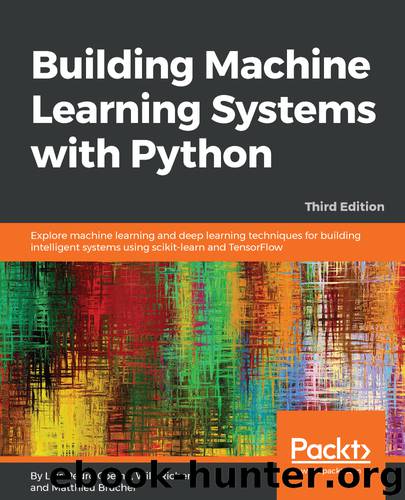Building Machine Learning Systems with Python by Luis Pedro Coelho

Author:Luis Pedro Coelho
Language: eng
Format: epub
Tags: COM062000 - COMPUTERS / Data Modeling and Design, COM044000 - COMPUTERS / Neural Networks, COM004000 - COMPUTERS / Intelligence (AI) and Semantics
Publisher: Packt Publishing
Published: 2018-08-06T11:04:58+00:00
In order to combine the methods, we will use a technique called stacked learning. The idea is that you learn a set of predictors, then you use the output of these predictors as features for another predictor. You can even have several layers, where each layer learns by using the output of the previous layer as features for its prediction. Have a look at the following diagram:
In order to fit this combination model, we will split the training data into two. Alternatively, we could have used cross-validation (the original stacked-learning model worked like this). However, in this case, we have enough data to obtain good estimates by leaving some aside.
Just as when we were fitting hyperparameters, we need two layers of training/testing splits: a first, higher-level split, and then inside the training split, a second split that can fit the stacked learner. This is analogous to how we use multiple levels of cross-validation when using an inner cross-validation loop to find hyperparameter values:
train,test = get_train_test(random_state=12) # Now split the training again into two subgroups tr_train,tr_test = load_ml100k.get_train_test(train) tr_predicted0 = predict_positive_nn(tr_train) tr_predicted1 = predict_positive_nn(tr_train.T).T tr_predicted2 = predict_regression(tr_train) tr_predicted3 = predict_regression(tr_train.T).T # Now assemble these predictions into a single array: stack_tr = np.array([ tr_predicted0[tr_test > 0], tr_predicted1[tr_test > 0], tr_predicted2[tr_test > 0], tr_predicted3[tr_test > 0], ]).T # Fit a simple linear regression lr = linear_model.LinearRegression() lr.fit(stack_tr, tr_test[tr_test > 0])
Now, we apply the whole process to the testing split and evaluate:
stack_te = np.array([ tr_predicted0.ravel(), tr_predicted1.ravel(), tr_predicted2.ravel(), tr_predicted3.ravel(), ]).T predicted = lr.predict(stack_te).reshape(train.shape)
Evaluation is as before:
r2 = metrics.r2_score(test[test > 0], predicted[test > 0]) print('R2 stacked: {:.2%}'.format(r2)) R2 stacked: 33.15%
The result of the stacked learning is better than any single method achieved. It is quite typical that combining methods is a simple way to obtain a small performance boost, but that the results are not earth shattering.
By having a flexible way to combine multiple methods, we can simply try any idea we wish by adding it into the mix of learners and letting the system fold it into the prediction. We can, for example, replace the neighborhood criterion in the nearest-neighbor code.
However, we do have to be careful to not overfit our dataset. In fact, if we randomly try too many things, some of them will work well on a particular dataset, but will not generalize. Even though we are splitting our data, we are not rigorously cross-validating our design decisions. In order to have a good estimate, and if data is plentiful, you should leave a portion of the data untouched until you have a final model that is about to go into production. Then, testing your model on this held-out data will give you an unbiased prediction of how well you should expect it to work in the real world.
Of course, collaborative filtering also works with neural networks, but don't forget to keep validation data available for the testing—or, more precisely, validating—your ensemble model.
Download
This site does not store any files on its server. We only index and link to content provided by other sites. Please contact the content providers to delete copyright contents if any and email us, we'll remove relevant links or contents immediately.
The Mikado Method by Ola Ellnestam Daniel Brolund(20724)
Hello! Python by Anthony Briggs(20010)
Secrets of the JavaScript Ninja by John Resig Bear Bibeault(18332)
The Well-Grounded Java Developer by Benjamin J. Evans Martijn Verburg(17688)
OCA Java SE 8 Programmer I Certification Guide by Mala Gupta(17496)
Kotlin in Action by Dmitry Jemerov(17308)
Algorithms of the Intelligent Web by Haralambos Marmanis;Dmitry Babenko(16319)
Grails in Action by Glen Smith Peter Ledbrook(15467)
Sass and Compass in Action by Wynn Netherland Nathan Weizenbaum Chris Eppstein Brandon Mathis(13331)
Test-Driven iOS Development with Swift 4 by Dominik Hauser(10417)
Windows APT Warfare by Sheng-Hao Ma(7833)
Layered Design for Ruby on Rails Applications by Vladimir Dementyev(7549)
Blueprints Visual Scripting for Unreal Engine 5 - Third Edition by Marcos Romero & Brenden Sewell(7452)
Solidity Programming Essentials by Ritesh Modi(4568)
Functional Programming in JavaScript by Mantyla Dan(4445)
Hands-On Full-Stack Web Development with GraphQL and React by Sebastian Grebe(4433)
WordPress Plugin Development Cookbook by Yannick Lefebvre(4389)
Unity 3D Game Development by Anthony Davis & Travis Baptiste & Russell Craig & Ryan Stunkel(4270)
The Ultimate iOS Interview Playbook by Avi Tsadok(4252)
